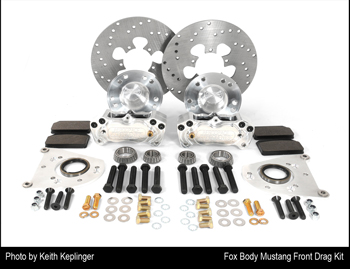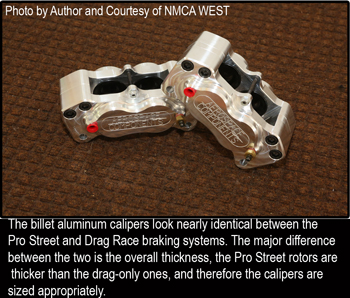In a world with a blurred line between street and race, Aerospace Components braking systems have a clear definition.
By Michael Galimi

In a world with a blurred line between street and race, Aerospace Components braking systems have a clear definition.
By Michael Galimi
In life we make a lot of decisions, for a gearhead one of the biggest choices when building a drag strip bound car (or truck) is to decide if it will be a racecar or street car. There are plenty of bench racing sessions that can make an excuse for a nitro Funny Car getting tagged and idled down Main Street, however when it comes to braking systems there is the proverbial line in the sand. Depending on which side of the line your vehicle sits, Aerospace Components has a specific braking system to suite its needs.
Aerospace Components has several application-specific designs for the Mustangs of any year, the latest generation Camaro, and general applications but when it comes to the type of use, the only two choices are Pro Street or Drag Race. Both types of brake systems utilize the same high quality parts like billet aluminum components, Hawk performance pads, exceed all NHRA/IHRA requirements, and all of brake kits are proudly made in the U.S.A. But the differences between Pro Street and Drag Race braking systems lie in the made in the U.S.A. But the di specifications.
Beginning with the rotors, Pro Street and Drag Race have drastically different performance life as drag racing brakes help decelerate the vehicle and then the car gets a break from the action. On the street, however, the braking systems are constantly in use as the rotors heat up, cool off, heat up, cool off, etc. during the typical stop and go traffic and longer drive time. That said, Aerospace Components builds its drag racing brakes to be lightweight for the ultimate in performance and it begins with a steel plate. The drag racing rotors are thin at just 5/16-inch thick and feature dilled holes to help save rotating weight. On the Pro Street side, Aerospace Components uses a cast iron rotor with a 13/16-inch thickness and its vented through the center so air can pump through the rotor and lower the temperatures quicker between  stops.
stops.
The calipers are designed nearly identical with the Pro Street ones being slightly thicker to fit over the matching rotors. In both instances, Aerospace Component calipers use four-pistons and are made in billet aluminum. Aerospace Components also offers single and dual piston calipers for certain dedicated drag racing applications. A set of dual rear calipers, which are popular in turbo applications and foot-brake racing, are available in both street and strip formats.The caliper mounting brackets that are included in Aerospace Components brake kits are slightly different for each application in order to accommodate the slightly larger diameter rotors.

Hawk brake pads are used exclusively in all Aerospace Components brake systems and the company uses different pads depending on the application. For Drag Racing kits, a more efficient cold stopping pad has been selected and it is far more aggressive than any street brake pad. The Pro Street kits include a brake pad that has a broader heat range and it is slightly less aggressive to help prevent wear on the softer cast iron rotors.
The line in the sand sits at 3,000 pounds and Aerospace Components is firm on that threshold along with street-use requiring Pro Street brakes, regardless of the minimum weight. As some enthusiasts make excuses for a thinly veiled racecar with license plates, the braking systems from Aerospace Components aren’t open for speculation.
Down-loadable PDF version available Here